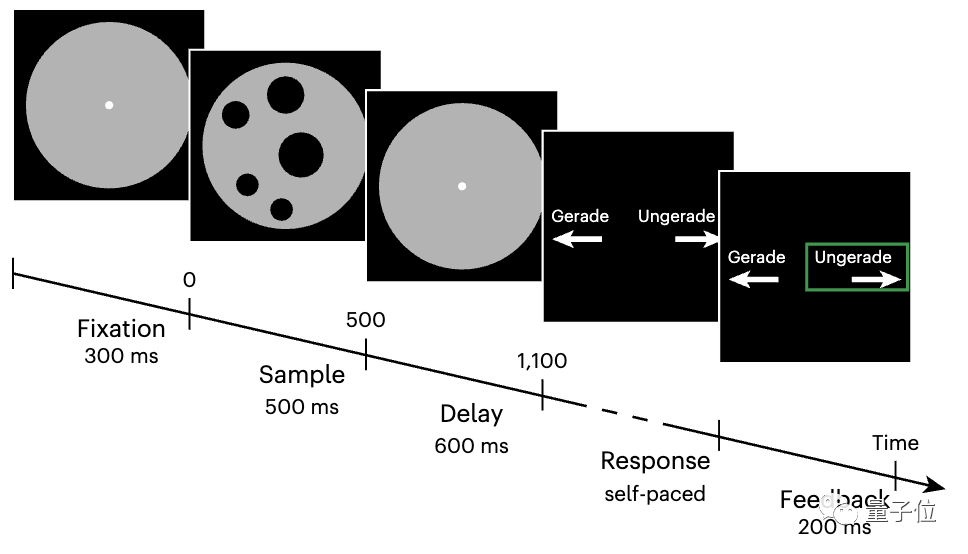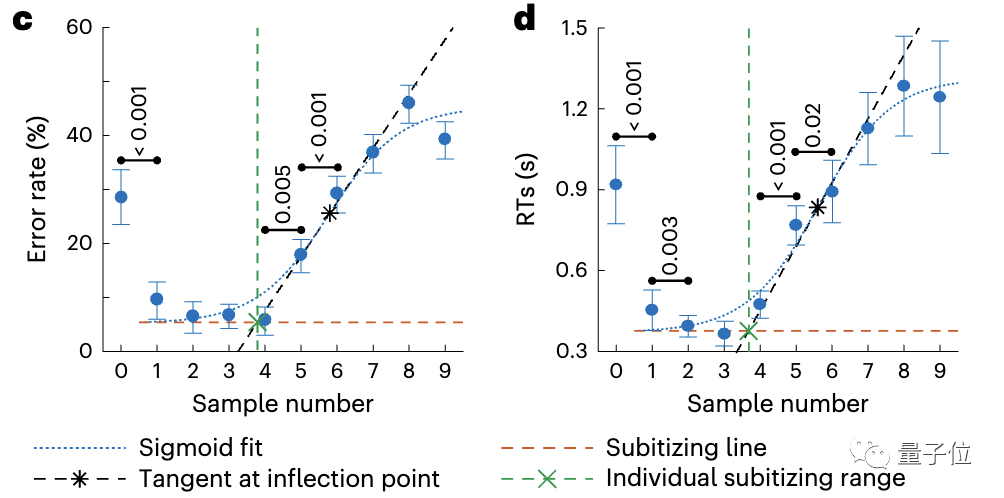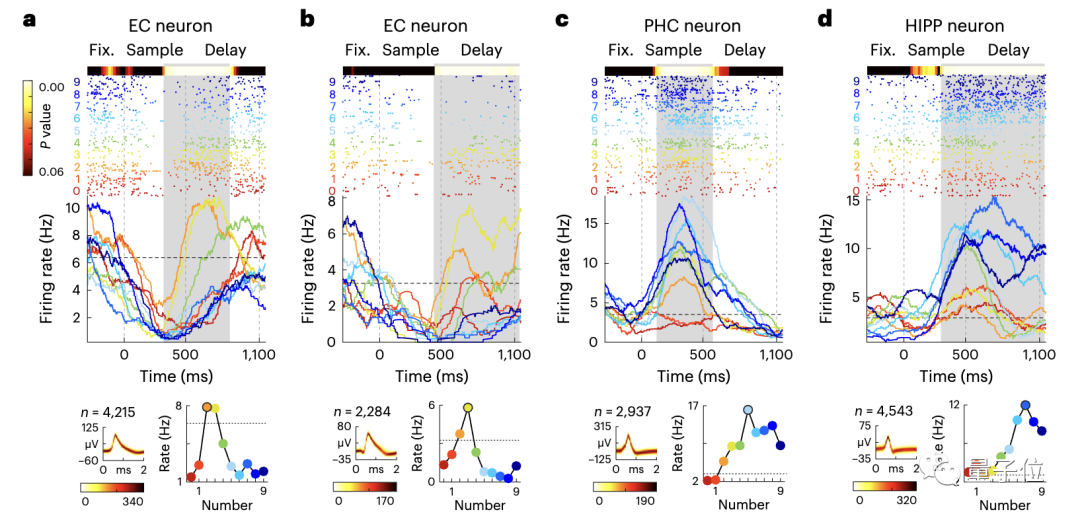 Technology peripherals
Technology peripherals
 AI
AI
 The human brain has cognition of the number '4', but not the number '5'! Scientific evidence supports that the four heavenly kings F4 are all '4' (doge)|Nature
The human brain has cognition of the number '4', but not the number '5'! Scientific evidence supports that the four heavenly kings F4 are all '4' (doge)|Nature
The human brain has cognition of the number '4', but not the number '5'! Scientific evidence supports that the four heavenly kings F4 are all '4' (doge)|Nature
Please answer within half a second. How many apples are there in the picture below:

Do you know at a glance that there are four on the left, and... many on the right? Why can't we instantly determine which one is on the right?
In addition to this phenomenon, there are some similar examples, such as the "Four" Great Heavenly Kings, F "4", "Four" Xiao Hua Dan, etc. Why does this all have to do with the number "4"?
Nature's latest report provides a direct basis to explain this phenomenon - The brain recognizes "4" but not "5".
Researchers from the University Medical Center of Bonn, Germany, observed the activity of single neurons and found that the brain uses a different system to recognize the number "1-4" and to recognize the number "5-9",The boundary is "4".
Specifically, when neurons process the number 1-4, specific neurons are used; while when processing 5-9, the response is not specific and will be interfered by adjacent numbers.
For example: a neuron that prefers the number 3 will only respond to 3, while a neuron that prefers the number 8 will respond to 8, but also to the numbers 7 and 9
This discovery is of great significance to understanding the nature of human thinking. Lisa Feigenson, a psychologist at Johns Hopkins University, said:
Fundamentally, the question involves the structure of the mind: What forms the basis of the human mind?
The human brain recognizes "4" but not "5"
In an article published in "Nature" magazine in 1871, economist and logician William ·Stanley Jevons investigated the human counting ability and came to the following conclusion:
Some people are unable to judge the size of the number "5"
Some people are unable to judge the size of the number "5"
Researchers subsequently analyzed that this was due to the brain using only one counting system, which is less accurate for larger numbers. Others hypothesized that the difference stems from the fact that there are two independent neural systems. The system was used to count and then further studied using techniques such as electroencephalography and functional magnetic resonance imaging, but the results were inconsistent and it was impossible to determine which model was correct.
Until recently, a research team from the University of Bonn in Germany used new technology to record the activity of single neurons in the human brain, and finally discovered the difference in neural coding between small numbers and large numbers.

Specifically, the data were obtained from 17 epilepsy patients. In order to help doctors find the source of epilepsy, these patients underwent invasive medical monitoring, that is, microelectrodes were implanted in the brain
While the patients underwent monitoring surgery, the microelectrodes recorded801 The activity of a single neuron. These neurons come from four areas of the brain: the amygdala, hippocampus, ventromedial temporal lobe, and ventrolateral temporal lobe.
During the recording process, the patient needs to do a quantity judgment task:
The screen will display non-symbolized "dot matrix" images in the range of 0-9, and each image will last half a second. . Participants need to press the left and right keys to indicate whether the number on the image is even or odd.

The dot matrix is presented in standard format and control format. The following are three dot matrix arrangements. :
△ (Left) Standard layout, the size and position of points are variable; (Middle) Control layout, the total area and density of points are balanced; (Right) Points are linear Arrangement
In the behavioral test, the patient's judgment of small quantities was significantly more accurate, and the reaction time was shorter, showing "subization" characteristics.
(Saturation, a term in psychology and cognitive science, refers to the human ability to quickly estimate small quantities of items.)
When After the quantity is greater than 4, the judgment slows down and the error rate increases, reflecting the "quantity estimation" process.
The researchers calculated the error rate and reaction time respectively, and finally determined that the upper limit of the subization range was on average 3.7 (error rate) and 3.6 (reaction time).

The analysis of neuronal responses further confirmed the accuracy of the behavioral results
Decimal digitization system & large number estimation system
In a single neuron At the meta-level, the researchers also observed similar coding patterns
They found neurons that selectively responded to non-symbolized quantities in the four recording brain areas, and these selective neurons covered 0 -9 complete quantity range.
The proportion of selective neurons in different brain regions is around 15.1%, which is significantly higher than random levels.
After analyzing the neuron tuning curve characteristics and correlations, the researchers found:
For small numbers 1-4, the neurons are highly selective for the preferred number and inhibit the non-preferred number Quantitative response, thus improving the recognition effect.
For a neuron that is sensitive to changes in quantity, it will produce the maximum response to a specific quantity. The quantity that causes the maximum response is the "preferred quantity" of the neuron
When the number is greater than 4, the tuning curve of the neuron becomes wider and the selectivity decreases, and returns to the baseline level as the number increases, which is consistent with the characteristics of number estimation

The researchers then further used SVM to decode selective neurons, conduct state space analysis and clustering analysis, and conduct statistics on neuron groups The test also found that there is a classification boundary for quantity judgment, and the most significant difference is between quantities 4 and 5.
This boundary is very consistent with human intuitive judgment
This study provides direct evidence that a system of "subitization" of small numbers and a system of "estimation" of large numbers can coexist
The "subized" system may be related to attention and working memory, which explains our sharp judgment on small amounts of information, while the brain needs to rely on slower and systematic information processing for input that exceeds capacity.
However, the researchers also mentioned that the more complex network mechanisms need to be further explored, such as whether there are similar coding differences in other brain areas and whether this phenomenon can also be observed in more complex cognitive tasks. Temporal effects of inhibitory loops, etc.
Paper link: https://www.nature.com/articles/d41586-023-03136-w
The above is the detailed content of The human brain has cognition of the number '4', but not the number '5'! Scientific evidence supports that the four heavenly kings F4 are all '4' (doge)|Nature. For more information, please follow other related articles on the PHP Chinese website!

Hot AI Tools

Undresser.AI Undress
AI-powered app for creating realistic nude photos

AI Clothes Remover
Online AI tool for removing clothes from photos.

Undress AI Tool
Undress images for free

Clothoff.io
AI clothes remover

AI Hentai Generator
Generate AI Hentai for free.

Hot Article

Hot Tools

Notepad++7.3.1
Easy-to-use and free code editor

SublimeText3 Chinese version
Chinese version, very easy to use

Zend Studio 13.0.1
Powerful PHP integrated development environment

Dreamweaver CS6
Visual web development tools

SublimeText3 Mac version
God-level code editing software (SublimeText3)

Hot Topics
 1378
1378
 52
52
 How to implement file sorting by debian readdir
Apr 13, 2025 am 09:06 AM
How to implement file sorting by debian readdir
Apr 13, 2025 am 09:06 AM
In Debian systems, the readdir function is used to read directory contents, but the order in which it returns is not predefined. To sort files in a directory, you need to read all files first, and then sort them using the qsort function. The following code demonstrates how to sort directory files using readdir and qsort in Debian system: #include#include#include#include#include//Custom comparison function, used for qsortintcompare(constvoid*a,constvoid*b){returnstrcmp(*(
 How to optimize the performance of debian readdir
Apr 13, 2025 am 08:48 AM
How to optimize the performance of debian readdir
Apr 13, 2025 am 08:48 AM
In Debian systems, readdir system calls are used to read directory contents. If its performance is not good, try the following optimization strategy: Simplify the number of directory files: Split large directories into multiple small directories as much as possible, reducing the number of items processed per readdir call. Enable directory content caching: build a cache mechanism, update the cache regularly or when directory content changes, and reduce frequent calls to readdir. Memory caches (such as Memcached or Redis) or local caches (such as files or databases) can be considered. Adopt efficient data structure: If you implement directory traversal by yourself, select more efficient data structures (such as hash tables instead of linear search) to store and access directory information
 How to set the Debian Apache log level
Apr 13, 2025 am 08:33 AM
How to set the Debian Apache log level
Apr 13, 2025 am 08:33 AM
This article describes how to adjust the logging level of the ApacheWeb server in the Debian system. By modifying the configuration file, you can control the verbose level of log information recorded by Apache. Method 1: Modify the main configuration file to locate the configuration file: The configuration file of Apache2.x is usually located in the /etc/apache2/ directory. The file name may be apache2.conf or httpd.conf, depending on your installation method. Edit configuration file: Open configuration file with root permissions using a text editor (such as nano): sudonano/etc/apache2/apache2.conf
 How debian readdir integrates with other tools
Apr 13, 2025 am 09:42 AM
How debian readdir integrates with other tools
Apr 13, 2025 am 09:42 AM
The readdir function in the Debian system is a system call used to read directory contents and is often used in C programming. This article will explain how to integrate readdir with other tools to enhance its functionality. Method 1: Combining C language program and pipeline First, write a C program to call the readdir function and output the result: #include#include#include#includeintmain(intargc,char*argv[]){DIR*dir;structdirent*entry;if(argc!=2){
 How Debian OpenSSL prevents man-in-the-middle attacks
Apr 13, 2025 am 10:30 AM
How Debian OpenSSL prevents man-in-the-middle attacks
Apr 13, 2025 am 10:30 AM
In Debian systems, OpenSSL is an important library for encryption, decryption and certificate management. To prevent a man-in-the-middle attack (MITM), the following measures can be taken: Use HTTPS: Ensure that all network requests use the HTTPS protocol instead of HTTP. HTTPS uses TLS (Transport Layer Security Protocol) to encrypt communication data to ensure that the data is not stolen or tampered during transmission. Verify server certificate: Manually verify the server certificate on the client to ensure it is trustworthy. The server can be manually verified through the delegate method of URLSession
 Debian mail server firewall configuration tips
Apr 13, 2025 am 11:42 AM
Debian mail server firewall configuration tips
Apr 13, 2025 am 11:42 AM
Configuring a Debian mail server's firewall is an important step in ensuring server security. The following are several commonly used firewall configuration methods, including the use of iptables and firewalld. Use iptables to configure firewall to install iptables (if not already installed): sudoapt-getupdatesudoapt-getinstalliptablesView current iptables rules: sudoiptables-L configuration
 How to learn Debian syslog
Apr 13, 2025 am 11:51 AM
How to learn Debian syslog
Apr 13, 2025 am 11:51 AM
This guide will guide you to learn how to use Syslog in Debian systems. Syslog is a key service in Linux systems for logging system and application log messages. It helps administrators monitor and analyze system activity to quickly identify and resolve problems. 1. Basic knowledge of Syslog The core functions of Syslog include: centrally collecting and managing log messages; supporting multiple log output formats and target locations (such as files or networks); providing real-time log viewing and filtering functions. 2. Install and configure Syslog (using Rsyslog) The Debian system uses Rsyslog by default. You can install it with the following command: sudoaptupdatesud
 Debian mail server SSL certificate installation method
Apr 13, 2025 am 11:39 AM
Debian mail server SSL certificate installation method
Apr 13, 2025 am 11:39 AM
The steps to install an SSL certificate on the Debian mail server are as follows: 1. Install the OpenSSL toolkit First, make sure that the OpenSSL toolkit is already installed on your system. If not installed, you can use the following command to install: sudoapt-getupdatesudoapt-getinstallopenssl2. Generate private key and certificate request Next, use OpenSSL to generate a 2048-bit RSA private key and a certificate request (CSR): openss




